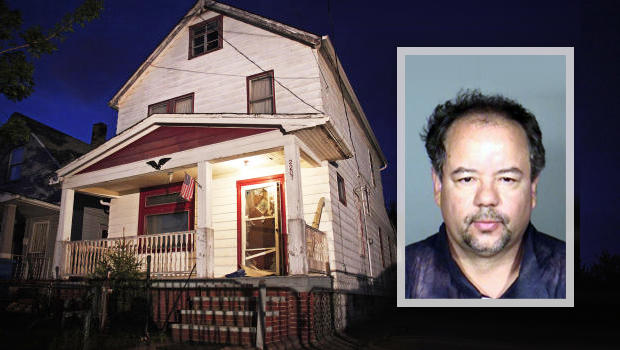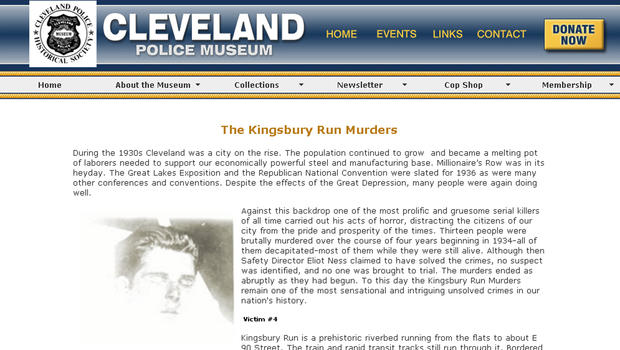Notorious Cleveland crimes
Cleveland is renowned for its sports fandom, world-class hospitals, and the Rock and Roll Hall of Fame. But the Ohio city has also been in the headlines for some unwanted reasons, as the site of number of notorious crimes that made national headlines. Read on for stories of some of Cleveland's darkest moments...
Michael Madison
Serial killer Michael Madison was convicted in May 2016 for the murders of three East Cleveland women -- Shirellda Terry, 18, Shetisha Sheeley, 28, and Angela Deskins, 38 -- between October 2012 and July 2013. In June 2016, he was sentenced to death.
The women's bodies were discovered in July 2013 near Madison's East Cleveland apartment. One was discovered in a garage, one in bushes outside and a third in the basement of a nearby vacant home, reports Cleveland.com. All were wrapped in trash bags.
Terry and Deskins were strangled, a medical examiner found, and Sheeley died of "homicidal violence by unspecified means."
According to Cleveland.com, Cuyahoga County Prosecutor Timothy J. McGinty described Madison as a trophy keeper who was inspired by another East Cleveland serial killer: Anthony Sowell.
A woman who described herself as the ex-girlfriend of Michael Madison told CBS affiliate WOIO in 2013 that Madison had a fixation on Sowell.
The woman, who asked to remain unidentified, told the station that Madison would frequently watch YouTube videos about the Sowell case and cry. She says he expressed sympathy for Sowell and disdain for his female victims.
Anthony Sowell
In 2009, Cleveland Police discovered 11 dead women in Anthony Sowell's East Cleveland home. The now-notorious serial killer was convicted in the murders in July 2011. The next month, he was sentenced to death.
Sowell was a registered sex offender when police went to his home on search and arrest warrants after a woman said he had raped her there. That's when they discovered two bodies upstairs and what appeared to be a freshly dug grave in the basement. Sowell was arrested two days later, on Halloween.
Eventually, police uncovered all 11 bodies.
Officials believe all the women were strangled, but decomposition made it difficult to determine cause of death for some of them. Officials said they could have been there for weeks, months or years.
The women began disappearing in 2007, and Cleveland's police force drew fire when their families accused them of failing to properly investigate because most were addicted to drugs and lived in an impoverished neighborhood. Some claimed police ignored their missing person reports.
In 2011, the city of Cleveland demolished Sowell's home.
Ariel Castro
On May 6, 2013, a Cleveland 911 dispatcher received a frantic 911 call from Amanda Berry, who had been missing since the day before her 17th birthday in 2003.
"Help me, I'm Amanda Berry," the caller said. "...I've been kidnapped. And I've been missing for 10 years. And I'm here. I'm free now."
The call revealed a harrowing ordeal for three young women -- Berry, Michelle Knight and Gina DeJesus -- who disappeared separately between 2002 and 2004 and were held captive for about a decade in the Cleveland home of Ariel Castro. They were rescued after Berry managed to escape and run to a neighbor's home. Police say Castro beat and sexually abused the women for years, fathering a child with Berry. The child was 6 years old at the time of her rescue.
In a plea deal that spared him the death penalty, Castro pleaded guilty to 937 counts, including aggravated murder, kidnapping, rape and assault in July 2013. He was sentenced to life in prison without the possibility of parole, plus 1,000 years.
"You took 11 years of my life away, and now I have got it back," Michelle Knight said in an emotional statement at his Aug. 1, 2013 sentencing hearing. "I spent 11 years in hell. Now your hell is just beginning."
Just over a month later, Castro was found hanging by a bedsheet in his cell. Authorities determined that he had committed suicide.
Held captive
The three women held captive in a Cleveland home for a decade broke their public silence in a video posted on YouTube on July 8, 2013. They said the support and prayers of family, friends and the public was helping them rebuild their lives after what Berry called "this entire ordeal."
In 2015, Berry and DeJesus published a memoir about their experiences. "We are free, we love life," the women wrote in the note to readers at the beginning of "Hope: A Memoir of Survival in Cleveland."
Knight, who legally changed her name to Lily Rose Lee, wrote a separate book about her experience entitled "Finding Me: A Decade of Darkness, a Life Reclaimed."
Jeffrey Dahmer
Notorious serial killer Jeffrey Dahmer admitted to raping, murdering and dismembering 17 men and boys between 1978 and 1991. Dahmer cannibalized and in some cases lobotomized his victims in the gruesome killings, and he kept body parts of his victims at the Milwaukee apartment where he was eventually arrested in July of 1991.
While he committed most of the murders in Milwaukee, he killed his first victim at his childhood home in Bath Township, about 20 miles south of Cleveland.
Dahmer, then just 18, killed a hitchhiker and disposed of his remains in the woods behind the property. He had recently graduated from nearby Revere High School.
"I didn't ever want freedom,"Dahmer said at his February 1992 sentencing hearing. "Frankly I wanted death for myself. This was a case to tell the world that I did what I did not for reasons of hate. I hated no one. I knew I was sick or evil, or both. Now I believe I was sick."
Dahmer was sentenced to 15 consecutive life sentences in prison. He was beaten to death in prison by a fellow inmate in November of 1994.
Cleveland "Torso Murderer"
A string of gruesome murders has been linked to the "Cleveland Torso Murderer" in Depression-era Cleveland. Investigators believe the still-unidentified killer murdered 13 people between 1934 and 1938, according to the Cleveland Police Museum.
Many of the victims were decapitated while still alive, and in many cases limbs were also dismembered. Some remain unidentified. Many were found near the Kingsbury Run riverbed, which runs through a neighborhood that at the time was impoverished and largely transient, according to the Police Museum. Some have referred to the slayings as the "Kingsbury Run Murders."
In 1939, brick layer Frank Dolezal was arrsted in the murder of one of the victims, Flo Polillo, according to the police museum. Dolezal confessed, though the confession was later called into question and Dolezal was found dead of a suicide in his jail cell soon after.
The case was investigated for years by famed Cleveland Public Safety Director Eliot Ness, though he never solved it.






